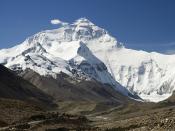A War of the Ages
A deep, haunting bass overcomes you as you step into the great Potala palace in Lhasa. Buddhist monks in their traditional bright orange robes lay prostrate on the floor in submission in a great, expansive hall. This is the capital city of Tibet, a formerly independent, autonomous region in Southwestern China. This region entails a perfect example of a peaceful, spiritual nation, unified by the bonds of a central religion. For thousands of years, the people of this region have demonstrated a respect for all culture, never lashing out in an unprovoked, military manner. That is, until 1950, when the invasion of this destitute, dignified country by the Chinese empire sparked a monstrous Tibetan, militant rebellion. This invasion, however was not without reason - by investigation of the history of the relation between both countries, one will be able to track the conflict between China and Tibet back to its roots, and to relate it to modern day occurrences.
Throughout all of Asian history, the people of Tibet have devoutly practiced the Buddhist value of non-violence, and have always been exceptional at abiding by this value for as long as the people have existed. Traditionally, all they want is a peaceful land in which to practice their religion and to support themselves by farming. The 13th Dalai Llama actually went out of his way to prevent any brand of confrontation with neighboring countries, especially China. One forms of prevention practiced by him was, unknowingly to the rest of his country, an annual sum of money sent discreetly to the Chinese emperor, in order to stay under the protection of China's wing. Keeping in mind how incapable the Tibetan government would have been at fielding a military can better justify these actions - living in...


